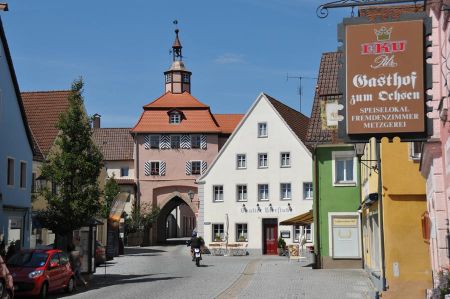Wassertrüdingen, a small town in Middle Franconia
- Written by Portal Editor
The interesting offer of a house to be restored in Wassertrüdingen from the 17th century with a detailed description of the “life cycle” of the house brought us to the medieval town of Wassertrüdingen.
The list of previous owners and their respective use brought us to the medieval town of Wassertrüdingen, a former market count town with 5,916 inhabitants today, located at around 420 meters above sea level in the Ansbach district.
Idyllically located between the heights of the Oettinger Forest in the southwest and the Franconian Lake District, which begins at Gunzenhausen, about 15 kilometers to the northeast, the town is located in the wide valley of the Wörnitz, a river that joins the Lentersheimer Mühlbach here. It is a little more than 7 kilometers to the Hesselberg, the only mountain in Franconia that, due to its height of 689 meters, offers a view of the Alps when visibility is good.
Wassertrüdingen - once a moated castle, today assisted living
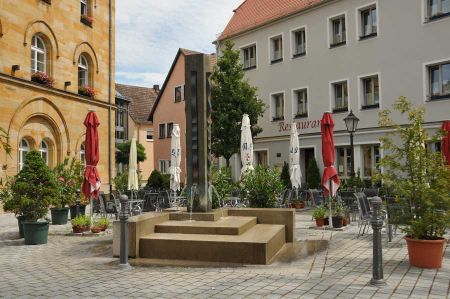 In the High Middle Ages, a moated castle was built here on the Wörnitz, which is now used for assisted living and can also be visited in some areas without disturbing the residents. In addition to the moated castle, a small town quickly developed under the influence of the Counts of Oettingen, which was first mentioned in 1242 under the name Wassertrüdingen. In 1371 the castle and the settlement passed to the burgraves of Nuremberg. The Reformation was introduced in the then margravial Ansbach city in 1528.
In the High Middle Ages, a moated castle was built here on the Wörnitz, which is now used for assisted living and can also be visited in some areas without disturbing the residents. In addition to the moated castle, a small town quickly developed under the influence of the Counts of Oettingen, which was first mentioned in 1242 under the name Wassertrüdingen. In 1371 the castle and the settlement passed to the burgraves of Nuremberg. The Reformation was introduced in the then margravial Ansbach city in 1528.
Tour under the direction of the city guide Schröder
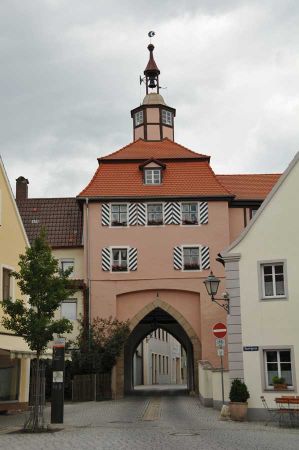 Due to our preliminary talks in the town hall of Wassertrüdingen with Mr. Peter Schubert and Ms. Andrea Schuelein regarding the house to be renovated, we were also able to enjoy an interesting tour through Wassertrüdingen under the direction of the city guide Werner Schröder. Starting at the town hall, which was built in neoclassical style from yellow sandstone in 1849/50, we begin the tour. A first reference to the landmark of Wassertrüdingen, the Obere Tor affectionately referred to as “Törle” and unfortunately the only one of the three former city gates that has been preserved, is made at the town hall. In 1752 the city gate was raised by one floor and the bell tower was built on it. The bell, which was cast around 1600, was donated by the then market count of Ansbach. Our route then leads past the Michaeliskapelle, the oldest church in Wassertrüdingen, the former synagogue, which only escaped the fire in 1939 because it was feared the fire could also endanger the outbuildings.
Due to our preliminary talks in the town hall of Wassertrüdingen with Mr. Peter Schubert and Ms. Andrea Schuelein regarding the house to be renovated, we were also able to enjoy an interesting tour through Wassertrüdingen under the direction of the city guide Werner Schröder. Starting at the town hall, which was built in neoclassical style from yellow sandstone in 1849/50, we begin the tour. A first reference to the landmark of Wassertrüdingen, the Obere Tor affectionately referred to as “Törle” and unfortunately the only one of the three former city gates that has been preserved, is made at the town hall. In 1752 the city gate was raised by one floor and the bell tower was built on it. The bell, which was cast around 1600, was donated by the then market count of Ansbach. Our route then leads past the Michaeliskapelle, the oldest church in Wassertrüdingen, the former synagogue, which only escaped the fire in 1939 because it was feared the fire could also endanger the outbuildings.
The moated castle - the starting point for the founding of the city
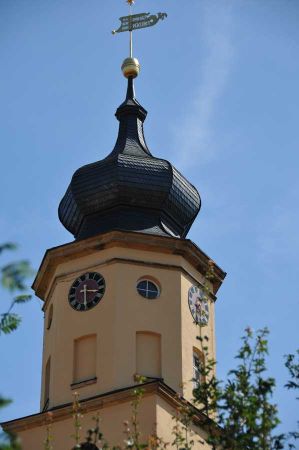 We come across remnants of the former city wall again and again during the tour, sometimes as free-standing elements or built into the houses.
We come across remnants of the former city wall again and again during the tour, sometimes as free-standing elements or built into the houses.
We are then pointed out to the second city gate, of which unfortunately nothing can be seen, the mill gate, which was destroyed in a major fire. A little further, however, is the still very well-preserved town mill, which was mentioned in a document as early as 1322 and was reconstructed in 1649 from old building material and according to the old plans. Now we come across the moated castle, the actual origin of Wassertrüdingen, where the ring wall and gate passage from the 12th century are still preserved and which was once called "Veste zu Wazzertruhendingen". Today, physically or mentally handicapped people and their carers use the moated castle as living space.
The City Church of the Holy Trinity
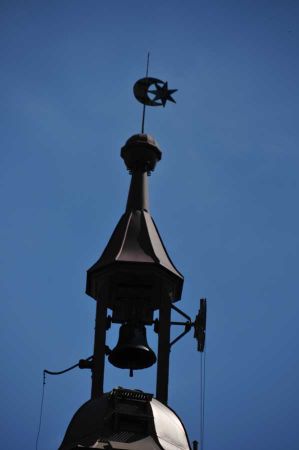 Between 1738 and 1740 Leopold Retti had the Evangelical Lutheran town church "Holy Trinity" built as the third residential church in the Margrave Baroque style. The choir, however, goes back to a previous Gothic church. The winged altar set up in the church with motifs from the Christmas story dates from around 1500. At the top of the church tower is a renovated tower house. Our tour ends at the puppet theater almost next to the “Törle”, but not without having been informed about the activities of the cultural meeting place. Various artists and associations use the open spaces of the former preparatory school for their activities.
Between 1738 and 1740 Leopold Retti had the Evangelical Lutheran town church "Holy Trinity" built as the third residential church in the Margrave Baroque style. The choir, however, goes back to a previous Gothic church. The winged altar set up in the church with motifs from the Christmas story dates from around 1500. At the top of the church tower is a renovated tower house. Our tour ends at the puppet theater almost next to the “Törle”, but not without having been informed about the activities of the cultural meeting place. Various artists and associations use the open spaces of the former preparatory school for their activities.
Bicycle tourism in the area around Wassertrüdingen
We would like to thank our city guide, Mr. Werner Schröder, for the entertaining city tour, which contained a large number of other hints and tips for the area. The former Roman camp in Ruffenhofen also seems so interesting that we want to visit it afterwards. Cycle tourism is also emerging more and more, because there are a large number of cycle tours in the area around Wassertrüdingen, which are easy to drive due to their location and lead through the beautiful landscape in the wide valley of the Wörnitz. Last but not least, Wassertrüdingen is on the German Alps-Baltic Sea holiday route.
We feel a certain feeling of hunger and come across a small Turkish snack located almost directly next to the town hall. You quickly become engrossed in conversations about life in Wassertrüdingen, because the Turkish owner has lived there for 20 years and our reports on Izmir and the greater Antalya area also meet with open ears and great interest. The kebab and ayran with the obligatory cay after the meal were always delicious.
The Ruffenhofen Roman Park was still under construction
Our subsequent visit to the Römerpark Ruffenhofen was then only of short duration, because even the access roads could not be used due to construction work. However, the museum building, which is still in the shell, as well as a number of existing display boards and finds in the outdoor area could be recognized. We will inquire when the completion can be expected and then come back.
Coordinates Wassertrüdingen:
49 ° 02'26.7 "N 10 ° 35'50.9" E or 49.040737, 10.597461
Please also read:
The Franconian Open Air Museum Bad Windsheim
Villa Rusticae in Bad Neuenahr - Ahrweiler
-
 Wassertrüdingen - unexpected perspectives
Wassertrüdingen - unexpected perspectives
Wassertrüdingen - unexpected perspectives
Wassertrüdingen - unexpected perspectives
-
 Wassertrüdingen - unexpected perspectives
Wassertrüdingen - unexpected perspectives
Wassertrüdingen - unexpected perspectives
Wassertrüdingen - unexpected perspectives
-
 Wassertrüdingen - unexpected perspectives
Wassertrüdingen - unexpected perspectives
Wassertrüdingen - unexpected perspectives
Wassertrüdingen - unexpected perspectives
-
 Wassertrüdingen - unexpected perspectives
Wassertrüdingen - unexpected perspectives
Wassertrüdingen - unexpected perspectives
Wassertrüdingen - unexpected perspectives
-
 Wassertrüdingen - unexpected perspectives
Wassertrüdingen - unexpected perspectives
Wassertrüdingen - unexpected perspectives
Wassertrüdingen - unexpected perspectives
-
 Wassertrüdingen - unexpected perspectives
Wassertrüdingen - unexpected perspectives
Wassertrüdingen - unexpected perspectives
Wassertrüdingen - unexpected perspectives
-
 Wassertrüdingen - unexpected perspectives
Wassertrüdingen - unexpected perspectives
Wassertrüdingen - unexpected perspectives
Wassertrüdingen - unexpected perspectives
-
 Wassertrüdingen - unexpected perspectives
Wassertrüdingen - unexpected perspectives
Wassertrüdingen - unexpected perspectives
Wassertrüdingen - unexpected perspectives
-
 Wassertrüdingen - unexpected perspectives
Wassertrüdingen - unexpected perspectives
Wassertrüdingen - unexpected perspectives
Wassertrüdingen - unexpected perspectives
-
 Wassertrüdingen - unexpected perspectives
Wassertrüdingen - unexpected perspectives
Wassertrüdingen - unexpected perspectives
Wassertrüdingen - unexpected perspectives
-
 Wassertrüdingen - unexpected perspectives
Wassertrüdingen - unexpected perspectives
Wassertrüdingen - unexpected perspectives
Wassertrüdingen - unexpected perspectives
-
 Wassertrüdingen - unexpected perspectives
Wassertrüdingen - unexpected perspectives
Wassertrüdingen - unexpected perspectives
Wassertrüdingen - unexpected perspectives
https://www.alaturka.info/en/germany/bavaria/5464-wassertruedingen-a-small-town-in-middle-franconia#sigProIde3c115d8b7
